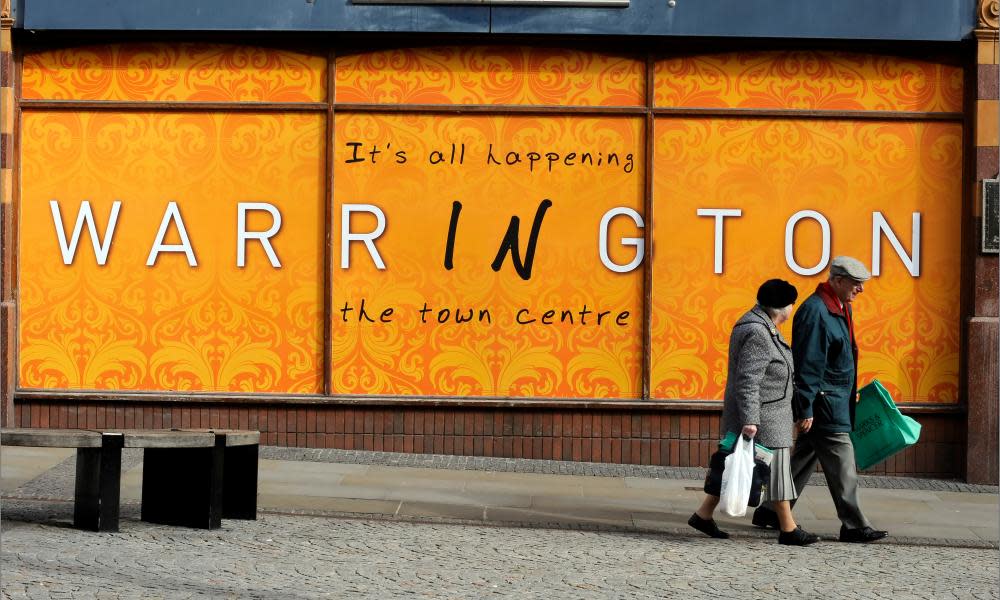Warrington moving to tier 3 coronavirus restrictions next week

Warrington has become the latest area in the north of England to announce it is moving to the highest level of coronavirus restrictions, but negotiations for other areas, including Nottingham, appeared to have stalled ahead of the weekend.
Warrington borough council said the Cheshire town would become a tier 3 area next week, with the exact date still to be confirmed. The council said it was getting £5.9m in central government support, made up of just under £1.7m for local testing and other public health measures and £4.2m to help businesses and staff.
But with Office for National Statistics data suggesting as many as one in 130 people had the disease in England in the previous week – prompting experts to warn of high, albeit slightly slowing, prevalence – talks over tier 3 status for Nottingham, Nottinghamshire and West Yorkshire were continuing.
default
Under this regime, pubs and bars must close unless they can operate as restaurants, while almost all mixing of households is barred and travel is discouraged.
Some reports suggested a deal had been made for Nottingham, as well as the surrounding boroughs of Rushcliffe, Broxtowe and Gedling, to move into tier 3 on Wednesday.
But sources involved in the negotiations said more details still had to be confirmed, including whether other neighbouring districts with rising coronavirus infection rates should also be moved up, not least to avoid people in tier 3 areas being able to cross a borough boundary to go to a pub.
A Downing Street spokesman said discussions were continuing: “As we’ve said on many occasions, the prime minister clearly wants to create the maximum possible local consensus.”
So far, Liverpool, Lancashire, Greater Manchester and South Yorkshire – areas with a combined population of 6 million – have gone into tier 3, amid prolonged wrangling over the amount of compensation offered to affected businesses and staff.
It is understood talks are also ongoing about a move to tier 3 in north-east England and Tees Valley; however, these discussions are not as urgent due to hopes of a fall in the areas’ Covid infection rate.
According to the latest ONS data, based on swabs from randomly chosen households, there were about 35,200 new cases a day in the community in England from 10-16 October.
The data suggests that at any given time during that week about one in 130 people had Covid – a total of about 433,300 people. That was a rise from one in 160 (336,500 people) in the previous week, and 224,400 the week before that.
default
The highest infection rates continue to be seen in the north-west and north-east of England, and Yorkshire and the Humber. But the ONS team added: “The gap between the northern regions and other areas seems to be narrowing.”
However, figures also show that while the R number, which shows the level of transmission, is at 1.2 to 1.4 in England, meaning cases are on the rise, the rate of growth has fallen in some regions, for example the the north-west, and the east of England.
Steven Riley, a professor of infectious disease dynamics at Imperial College London, who was not involved in the ONS survey, said the situation was concerning.
Related: Andy Burnham: former New Labour high flyer cast as 'king of the north'
“Prevalence is high and still increasing rapidly,” he said. “There may be some sign of a slight slowdown, but, given the urgent need for prevalence to start to go down, we should not focus on small reductions in a still positive growth rate.”
The latest estimates for new infections are on the lower end of those released by the MRC Biostatistics Unit Covid-19 Working Group, which on Wednesday suggested there could be between 35,100 and 82,100 new infections a day in England.
But the ONS figures confirm a trend that will cause deep concern: cases are seeping into the older population.
“There has been growth in Covid-19 infection rates in all age groups over the past two weeks including those aged over 70 years, with the current rates highest in older teenagers and young adults,” the ONS team reports.
A No 10 spokesman reiterated the government’s hope for people in England to be able to hold somewhat normal Christmas celebrations, while giving no details of how this might happen.
“The prime minister has been clear previously that he is hopeful that in many ways we could be able to get some aspects of our lives back to normal by Christmas,” he said. “We’ve been clear about the ambition to ensure that people may be able to celebrate Christmas as a family this year.”


